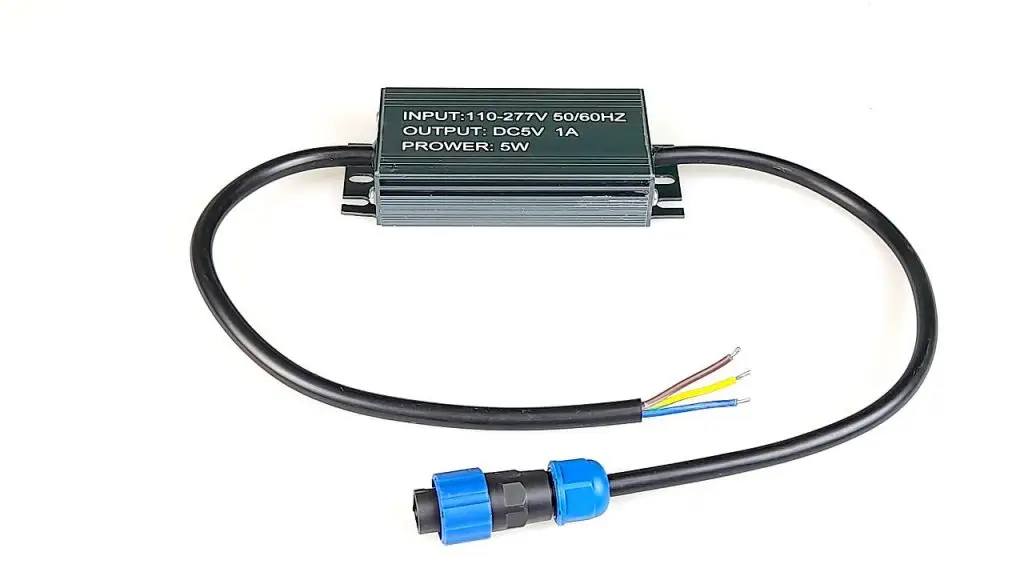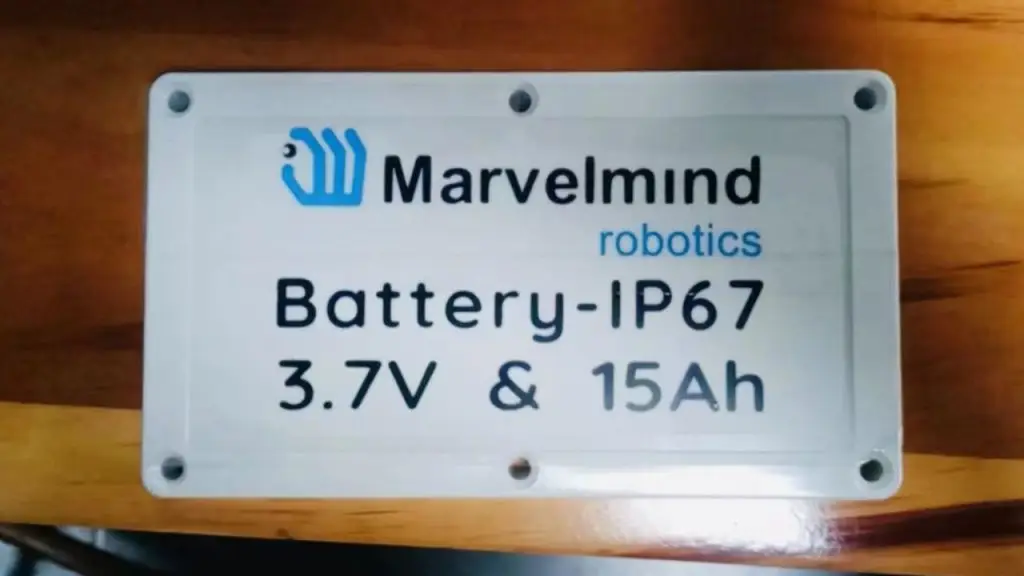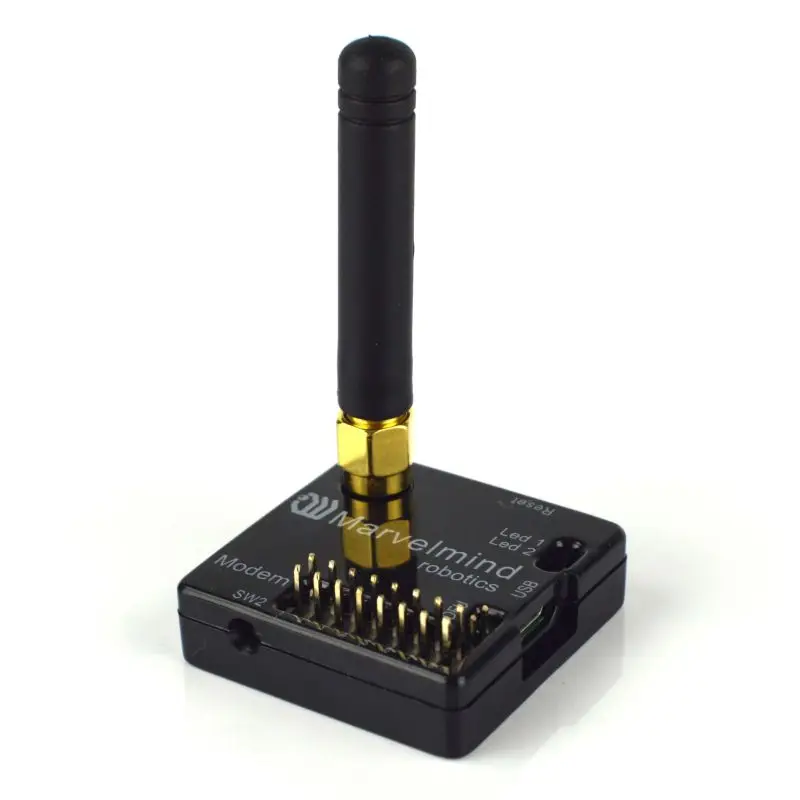Power supply options for beacons
The best and recommended way to power the beacons of the indoor positioning system is to have a fixed external power supply.
For Super-Beacons, we recommend regular AC to USB converters or USB chargers.
For Industrial Super-Beacons:
- AC to +5V converters or chargers (newer batches of Industrial Super-Beacons
- AC to +12V converters or chargers (older batches of Industrial Super-Beacons)
Notice! Newer Super-Beacons are +5V power supplied – not +12V power supplied. Applying +12V to newer batches of Super-Beacons (produced in 2022 and later) will kill them.

Our converters and chargers support ~110V and ~220V. Thus, you can easily use them in Europe, Asia, and the Americas. Remember about different plugs, though.
Some converters come with external plugs. However, some come with open wires on the input side and are designed to be connected to your warehouse’s and factory’s electricity grid.
External power supplies give peace of mind and freedom to focus on other aspects of the system.
Though we strongly advise using an external fixed power supply, different battery options are available if the fixed power supply is not feasible. Even more exotic options, like solar panels, could also be helpful in some special applications.
Before we go deeper into the power supply variants, let’s discuss what to pay attention to and why.
Defining factors for the power supply options
Powering of modems is not a problem
First of all, notice that we don’t discuss powering of modems. Modems are nearly always active. They typically don’t sleep. In the majority of cases, they are even computer connected. Thus, powering them is typically not an issue: either they are USB-connected and powered via USB, for example, Modem v5.1 or the power is readily available via ~220V to +5V (+12V for older batches) converter for the Super-Modem.
Mobile beacons vs. Stationary beacons
Stationary beacons (anchors) have fixed locations. See more in the Placement Manual.
At first glance, one may think that providing power to them is not a problem, and the primary focus shall be on the mobile beacons. Thus, there are claims of 1-year, 3-year, and 5-year battery lifetime for tags in UWB or BLE systems…
But in reality, it is the opposite in the majority of cases:
- To provide power to stationary beacons is simply costly: cables, wiring, work, permits, restrictions
- The stationary beacons are placed high on the wall or ceilings, and often one needs a special permit to access the area to install the beacons, wire the power supply, or change the depleted battery. Such works are often expensive or restricted, i.e., even more expensive
- Basic ~110/220V wiring + converters may be the least expensive option. PoE can be costly and an overshoot, notably if you don’t need Ethernet. Try to find solutions that wouldn’t require costly data wiring to each stationary beacon (anchors). Note, that the majority of UWB system do require PoE and Ethernet connectivity to their anchors and that the major part of the total cost. Wireless options for data connectivity are the best. Wireless for connectivity + basic fixed power supply is the best
- Batteries are not recommended for stationary beacons unless not avoidable because, with batteries, there are always risks and limitations: (1) you accidentally forget some settings, and the battery will run out of energy in days rather than weeks or months; (2) Sooner or later the battery must be replaced (very bad) or re-charged (much better) – but still, it is a potential interruption and additional work, for sure; (3) you will have to sacrifice/compromise the performance to find a balance between the battery lifetime, battery costs and the update rate, range, etc.
Mobile beacons, on the other hand, are typically either powered by the electrical grid of a robot, drone, or forklift or charged often (daily, weekly) because, unlike stationary beacons, they are easily accessible and people are used to charge their devices: phones, cameras, players, lights, etc., i.e. it is not something they resist much.
Therefore, it is important to very clearly understand that powering mobile beacons (tags) is typically not a problem. But powering of stationary beacons could be due to the cost or limitations of wiring or size and costs of required batteries and associated battery replacement/utilization and recharging costs.
Beacons sleep most of the time
Like the majority of other modern electronic devices, Marvelmind beacons sleep most of the time. They wake for a very short time, do the job, and go to sleep immediately in order to save energy.
Beacons have a duty cycle with highly irregular power consumption: some milliseconds of relatively high current during the active phase are followed by tens or hundreds of milliseconds of nearly zero current during the sleep phase. The difference in current consumption between the modes is 1000:1 or even more.
Typical power consumption pattern:
- Wake up into a low consumption mode. Wait for a trigger via radio from the modem
- Receive a radio signal from the modem – “time reset”
- Either emit or receive ultrasound – depending on the mode of operations
- Process the data
- Transmit the resulting data to the modem and to an external user connected to the beacons
- Go to sleep until the beginning of the next cycle
As a conclusion:
- It is not very correct to talk about “average power consumption”. It is possible to talk about “the average power consumption with a specified location update rate and other settings”
- Battery lifetime most of all depends on the location update rate. The dependence nearly linear: for 1Hz the battery lifetime will be nearly 10 times longer than for 10Hz
Location update rate is the most important parameter for battery lifetime
As discussed above, the beacons sleep most of the time. Thus, it is possible to calculate a required energy for a single location update. By knowing that energy and by knowing the battery capacity, it is possible to calculate the number of location updates the battery can provide before it will depleted.
For example:
- The battery has a capacity of 1Ah
- The beacon consumes 1mAs (0.001mA*1/3600h)
- The battery will be able to provide roughly: 1Ah/1mAs=3 600 000 location updates
- You can consume them with 1Hz or with 8Hz update rate, for example
- With 1Hz location update rate it will result in 3.6e6/(1*60*60*24)=41 days
- With 8Hz location update rate it will result in 3.6e6/(8*60*60*24)=5.1 days
As it can be seen, the difference is drastic.
In reality, the difference is less dramatic, because there is a current in sleep mode as well, which is not zero after all. Thus, if the sleep time is long, the sleep current starts notably contributing to the total power consumption. For a 1-year battery lifetime, the sleep current consumption may prevail over the active current consumption.
Recommended power supply options
Stationary beacons
External fixed power supply is the best and most reliable choice.
- Supports both 110V and 220V AC
- It is a typical +5V USB converter. Other similar USB converters or even USB chargers giving 0.5-1A or more work just fine
- Intended for a wide range of applications when the beacon/modem is stationary and AC power supply is easily available
- Usually, the least expensive and the most recommended option
- Supports: Super-Beacons, Mini-TX, Mini-RX, Beacon-UWB, Watch, Helmet, Jacket, Cap, Modem v5.1, and their outdoor versions
AC to +5V (+12V for older batches) converter:
- Supports both ~110V and ~220V AC
- It is a special IP67 converter for Industrial beacons and Super-Modem
- Intended for a wide range of applications when Industrial Beacons or Super-Modem are stationary and the AC power supply is easily available
- Usually, the least expensive and the most recommended option
- Supports all types of Industrial Beacons: Super-Beacon, Industrial-RX. Supports Super-Modem
Mobile beacons
Special options for powering beacons externally: cases with removing batteries, replacing the USB connector, powering via the 4×4 pins.
External DC-DC power converters are the best and most reliable choice for mobile beacons:
DC to USB or DC to +5V (+12V for older batches) converter:
- Supports up to +48V DC input voltage
- The output connector is a 4-pin IP67 connector matching Industrial Super-Beacons, Industrial-RX, Super-Modem
- Intended for a wide range of applications when the beacons/modems are mobile, for example, installed on a robot, drone, or forklift and the DC supply is available from the mobile vehicle
- Usually, the least expensive and the most recommended option

In many cases, an external USB power supply is available. You can connect a micro-USB connector to the beacon and get both power and the data stream to and from, for example, Raspberry Pi or Nvidia Jetson.
Similar can be done with an Industrial beacon or modem, if external +5V (for older batches – +6V…+15V) is available from the onboard sources of the mobile vehicle/drone/robot.
Battery power supply
Internal battery
The majority of Marvelmind devices have internal LiPol batteries. Typically, it is a 3.6V cell. For example:
- Super-Beacons: 900-1000mAh & 3,6V
- Mini-RX (Helmet, Jacket, Cap): 500-700mAh & 3.6V
- Mini-TX: 250mAh & 3.6V
Some devices have additional external batteries; for example, the Headlight has two larger-capacity external LiPol cells that extend the capacity of the internal battery by a factor of 3-5 – depending on the chosen external cells.
Other devices, like robots, have massive internal batteries – up to 96Wh for Boxie and expandable; and 740Wh and expandable for Robot v100. Those batteries supply the robots’ motors, electronics, and beacons on board.
Industrial beacons don't have internal batteries
Industrial beacons intentionally don’t have internal batteries:
- The beacons are designed to work in an extended temperature range of -40C..+60C (provided by design. Not tested nor guaranteed). But regular LiPol batteries can’t take charge with temperatures below 0C – they may be irreparably destroyed. Moreover, the charge inside the batteries drops by a factor of 2-3 at least, when the temperature drops to -20C..-40C, thus making them the low capacity
- LiPol batteries are good, but they are one of the least reliable elements of the system, and even the best batteries are prone to bulge and other nasty surprises. It is particularly undesirable for industrial beacons
External battery options
USB power banks
USB power banks are the simplest and the most straightforward way to expand the battery lifetime of Super-Beacons or other USB powered beacons. Notice the following though:
- The majority of the USB power banks are too “smart” and they cut off power supply when the beacon is fully charged and doesn’t require energy. In order to restart it, one needs to connect and disconnect the power bank or press the ON button, which is impossible if the beacon is high off the ground, for example. See more in the video
- Power banks are often misleading. They often state, for example, 10,000mAh capacity highly visible, but it could be the capacity of the internal 3.6V LiPol battery – not the resulting +5V battery. Thus, the total energy capacity is not 10*5=50Wh, but 10*3.6=36Wh. Be aware
- Many power banks simply lie about their capacity. It can be written 15,000mAh, whereas the real capacity is just 5,000mAh
- Resulting battery lifetime increase would be close to Battery capacity/internal battery capacity using Measure and Extrapolate method. Thus, if you have a fully charged 10,000mAh power bank, you can expect 10x increase in the beacon working time – from 3 days to 1 month – with 8Hz and default settings for Super-Beacons. With power saving features enabled and update rate of 0.5Hz, the same power bank could last for a year. But that would already depend on the self-discharging of the power bank. They often have much shorter self-discharging time
Battery-3.7V-15Ah-IP67
External Battery-3.7V-15Ah-IP67 is the simplest battery supply option for Industrial beacons and Super-Beacons. With default settings and an 8Hz update rate, it provides about 15 times longer working time than the embedded battery (depending on the mode and size of a submap). With different settings and with a slower update rate, it can last for a year if needed.

External Battery-3.7V-15Ah-IP67 can be charged with Charger-3.7V-3A-IP67.
Customized high-capacity LiPol batteries
For those he really need batteries, we are offering customized external LiPol batteries. Then can be literally any capacity, voltage and and size. You need a 1 year battery lifetime – not a problem! 5years? – not a problem either.
Options:
- LiPol cell 3.6V & 43Ah – up to 1-2 years for Super-Beacons
- Similar options for smaller or larger capacity or different shape or implementation – on request
Battery lifetime
Mathematical calculations
Though possible, it is rather difficult to calculate an expected battery lifetime mathematically because:
- Many moving variables
- High uncertainty of actual power consumption because it consists of pulses with not exactly known current and not precisely known time
- Too high risk of not taking into account some factors that may eventually prevail: battery leakage current, undocumented surge currents, the effect of different temperatures on the current consumption and actual battery capacity, etc.
Besides, pure mathematical calculations leave too much room for uncertainty and a design to measure in practice to prove the validity of the results.
Pure power consumption measurements
It is possible to measure the current consumption of each element of a cycle and integrate it. It is possible but challenging, and still not very reliable because:
- It isn’t easy to measure 1000mA and 0.1uA during the same cycle. Each pulse can be as short as a millisecond or even less in some case
- High uncertainty due to different temperatures and multiple modes of operations
- Measurement devices may alter the actual power consumption
Measure and extrapolate
The best option in practice is to measure the actual battery lifetime and extrapolate it keeping in mind the underlying physics:
- It is possible to estimate a point with given settings. Other settings and other modes of operation will require different calculations
- For example, if with an internal battery of 1Ah, the beacon worked for three days (72h), it could be pretty confidently confirmed that with a 10Ah battery, it will work for 30 days
- If the beacon worked thrice with 8Hz, the expected battery lifetime with 1Hz would be slightly less than 24 days. (Note that it is subject to power-saving features. In some cases, the power-saving features can be disabled for more stability or accuracy. Thus the reduction from 8Hz to 1Hz update rate may bring only very little difference)
Other factors affecting power consumption and battery lifetime
There are many factors affecting the battery’s lifetime. The most affecting – the location update rate – was already covered earlier. What else:
- The size of the submap. The larger the distance, the longer the system has to listen to the ultrasound and the more it has to process the data. Thus, the current consumption per cycle is longer. In some cases – large submaps of 30m and the highest possible update rate – the beacons don’t sleep at all
- Radio profile. The higher the baud rate (38kbps vs. 500kbps), the more extended radio shall be on and the more energy it will consume. The operating range and interference resistance should have a 38kbps radio profile. But the battery should have a 500kbps radio profile
- The mode of operation. Ultrasound transmitting beacons have very short (1ms) but mighty peaks. But then they sleep very long in terms of the cycle. The ultrasound-receiving beacons do not have high-power consumption peaks. But they have to listen to the ultrasound and process it digitally for a significantly longer time (100ms) than the ultrasound transmitting beacons. Thus, the resulting total power consumption during the cycle can be even larger
- Temperature. Beacons can work down to -20C but remember NOT to charge them before they have a temperature above 0C. Negative temperatures reduce the battery capacity by a factor of 2..3, or even more in some case
Special solutions - for advanced users only
Powering Super-Beacons and Beacons HW v4.9 via 4x4 pins
- The battery pins on the 4×4 pins are primarily designed to supply external devices from the internal battery. However, it is possible to supply the beacon as well, if done with understanding and with met requirements in the bullet points below
- The pin is directly connected to the internal LiPol 3.7V battery. It means that one can’t just provide +5V to the pin, for example. It will kill the battery with all the dire consequences of LiPol battery potential fire
- One shall either provide a supply from a LiPol 3.7V battery charger or connect an external LiPol battery to the pin. The batteries must have approximately the same voltage as an internal battery when they are being connected. For example, 3.6V on the internal and 3.7V on the external battery is OK. However, 3.2V on the internal and 4.2V on the external battery is not OK because it will shock the internal battery, which may result in its fast wearing, overheating with charging, etc.
- It is possible to disconnect the internal battery completely: carefully unsolder it or cut the wires one by one – don’t make a short circuit. In this case, you won’t have the internal battery, but you will be able to supply 3.7-5.5V from an external source capable of providing 1A or more peak current
